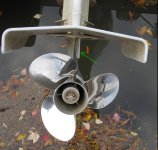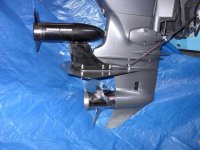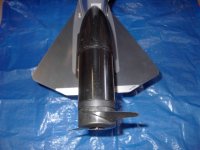The trailing edges of my prop have "rainbow" coloration on the trailing edges of the stainless prop. I am told this is the result of cavitation. I know of only one time when I knew cavitation was occuring. That was when the lower unit was fouled with seaweed.
The boat is an '04 CD-25. Engine is a Honda 135 with a permatrim.
I notice that there is a small fin mounted to the underside of the anti-cavitation plate -- and that the fin is cocked off center to starboard. Should it be angled off center? Could this be causing cavitation?
In this photo the fin I am referring to is marked with a green arrow. (The camera did not capture the coloration on the blades.) Thoughts?

The boat is an '04 CD-25. Engine is a Honda 135 with a permatrim.
I notice that there is a small fin mounted to the underside of the anti-cavitation plate -- and that the fin is cocked off center to starboard. Should it be angled off center? Could this be causing cavitation?
In this photo the fin I am referring to is marked with a green arrow. (The camera did not capture the coloration on the blades.) Thoughts?




